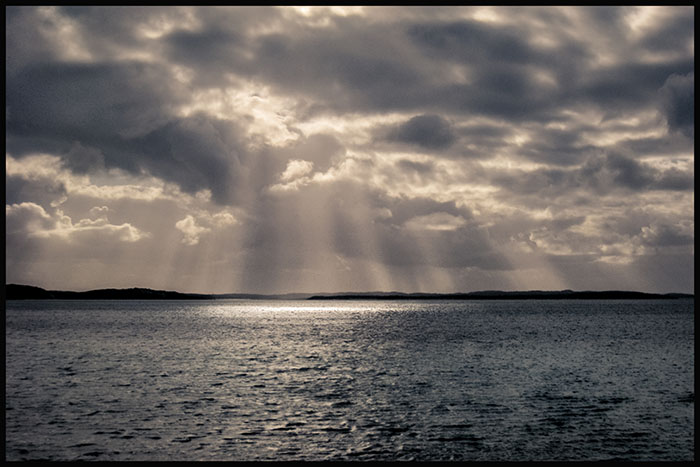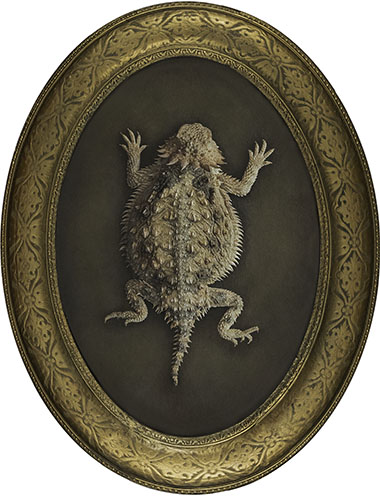Journey

It was such a pleasure to work with Kate Breakey and curate the exhibition we ultimately titled Journey. I had seen several of Kate's extensive series featured in numerous publications and exhibitions over the years. Always sensitive, insightful; consistently bridging the gap between the intimate and the universal in a single image. Fascinated by the arc of her forty year career and the wide range of techniques mastered, I suggested that we explore her journey as an artist by presenting the range of subjects, concerns, research and techniques that have become Breakey's artistic signature.
Judy Tedford Deaton: Can you elaborate on your statement that you paint, gild or embroider the images in an attempt to make the subjects special and divine?
Kate Breakey: A "straight" photograph is a fairly quick thing to make—especially in the digital era, easily reproducible and immediately readable because we are so familiar with photographic images. I have always changed my photographs by layering them with other media, to make them more personal and subjective. It is probably due to having had a painting and printmaking education in art school. I have always been attracted to the sensual nature of paint, pastel, ink and expressive "mark making." Hand working the surface of a photograph makes it less photographic and more like a drawing or painting. By reworking the details, I draw attention to the subject, and the careful and sometimes painstaking devotion to this conveys my reverence and respect. The intention is to make people look and appreciate the sheer beauty of the natural world, feathers and fur, or petals and leaves, seas and skies, all lovingly embellished a bit.
JTD: You are one of the few photographers I have worked with who personally frames each work in a unique way. Do you consider the presentation part of the process?
KB: Yes, absolutely. A frame is an extension of the edges of an image, and makes it a finished object. The frame shape and thickness, and especially the color, can change the whole mood and status of the image. An image can be made grand and commanding, or delicate and gentle, or quirky and playful, so frame choice really matters. I'm always astonished by how completely different an image looks depending on how it's framed. Not enough artists pay attention to this aspect of presentation. You want to ensure you are amplifying your message, not negating it. Sometimes I like to use vintage frames because they hark back to a time when photography was new and more precious, so they place the image in the context of history and the very different way we thought about the world. There is also something poetic and sort of absurd about putting an image of a small dead rabbit or lizard in an elaborate turn-of-the-century oval frame that was meant for a formal portrait. I enjoy the process of finding the perfect frame that further expresses how I feel about the subject, how I want it to be seen.

JTD: You spoke of your work as a diary of what you have seen and loved as well as a way to preserve what is wild and transient. Can you elaborate on the power of art to preserve and present fleeting moments that might be otherwise overlooked?
KB: Visual art has the ability to stop and engage us emotionally or intellectually. I would like to think that I invite a viewer to share the wonder I feel—whether it's witnessing the moment of a patch of sunlight on a vast ocean or noticing a tiny dead bird or watching the moon rising and setting. The world is so beautiful, so elusive, so vast and complex and yet so ephemeral . . . which is why I go through life with a camera, to record these things, to capture them before they disappear. Making images is, of course, a way to possess those moments, so that I can remember being struck by the them, and never forget the light or shape or space or color—any of the tiny details that have touched me. The work is like a diary because it's a record of what has moved me and matters to me in my brief existence on this planet and I always hope others can relate to that because we are all human.
JTD: Do you have a personal cabinet of curiosities?
KB: Yes, although nothing as exotic as this term implies, since in this age of information nothing is mysterious anymore—our curiosity can easily be satisfied with Google. I do and always have collected things that I find fascinating and beautiful, mostly for the purpose of photographing them. Childhood visits to the natural history museum were what first piqued my curiosity about the biological world. I loved idoramas and being amazed by the glass cases filled with shells and birds, nests and plants—all labeled and classified. I marveled over the beauty and mystery of the seemingly endless diversity of life and I understood precisely the need to preserve and display everything, forever. Wandering among the specimens, it seemed to me that all these things radiated a sort of silent secret message, the essence of which was indecipherable and incomprehensible—a secret to be contemplated for a lifetime. The wonder, the intrigue, and a desire to have my own collections to look at never left me. I still came back from a beach with pocketfuls of rocks and shells, leaves and bones, things a lot of people would find ordinary.
JTD: It has been noted that you have an incredible work ethic and prodigious output. What drives you to create such time consuming and meticulous works of art?
KB: I love the process of making art and I can't think of anything I'd rather be doing. It's always been my greatest joy—the way I express wonder and love. Life is complicated; making art gives me peace and solace. I find the time consuming or meticulous part very relaxing. Like most creative processes, the focus and discipline carries you to a place outside yourself, so it's a form of meditation. I'm lucky that artmaking is a passion, an energizing addiction, and that makes me more productive I suppose.

JTD: You mentioned that each series is ongoing. Do you work on several series simultaneously?
KB: Yes—it seems that nothing is ever finished and because there's always more to see and say on any subject as time goes in, plenty of beautiful trees to see and add to the "tree series" that I started back in the 1980s, just different ways to see them using different processes. Fifteen years ago I transitioned from "analogue" (shooting film and printing in a darkroom) to digital, and began using different mediums which allowed for other ways to work. I group bodies of work together thematically, that I call a "series," but sometime ideas branch out from one another, evolving tangentially, and new subset series are born. However, everything really overlaps—if not visually, at least in spirit, so sometimes there are no defined beginnings and ends to any series because the way I feel about things doesn't change, just my approach to conveying it changes. So there are really just series within series, and if I am doing something new it's still being informed by everything I've done before. The production of work and ideas isn't linear; you abandon a lot of things circling back to them later so you can never define a series by dates and times anyway. When I have my camera I think I'm always working on—looking for—everything all at once, but I can only make a fraction of the pictures I take into finished objects. So I shuffle between the series all the time and probably always will. I think a lot of artists, perhaps especially photographers, work like this.

JTD: The exhibition included orotones, infra-red motion sensing images, digital prints hand colored with pencil and pastel, embroidered prints on silk, silver gelatin photograms, silver gelatin photographs hand colored with oil paint, and a wide variety of subjects from landscapes and skyscapes to intimate detail closeup portraits of animals. How do you select a particular process for each subject or series?
KB: I no longer shoot film or print in a darkroom, so all the the silver gelatin images are from older stores of artwork made either before digital photography or specifically to make the photograms which require light sensitive materials as they can't be done digitally—so I don't do these anymore. I've learned the post processing tools, and techniques in apps like Lightroom and Photoshop, so I can alter images in this way and print them digitally on multiple different substrates—silk, canvas, cotton rag watercolor paper—and then I play with altering the physical surface with media like paint, pastel and pencil. It's always a process of discovery. I did eventually decide to print the nests on silk when I knew that was an option, because I had it in mind to embroider them with thread to make them three dimensional. I could visualize this but I didn't really know if it would work until I did it. It's all experimental because the possibilities are now dauntingly endless, so it's a search for what works. It's often surprising, sometimes frustrating but mostly exhilarating.
JTD: What do you see as the next step in your journey?
KB: I have too many ideas for work I'd like to make; unfortunately I feel I need another lifetime. After what we have been through recently and the uncertainty of what is to come, it's easy to feel powerless and depressed and think "what's the point." But I can't not make art, so I am trying to stay inspired and be appreciative of every moment I have, and I'll continue patiently to try to send the message that the natural world is fragile and precious and should be honored and cared for.

Kate Breakey is internationally known for her large-scale, richly hand colored photographs including her luminous portraits of birds, flowers and animals in a series called Small Deaths published in 2001 by the University of Texas Press. Her other monographs include Painted Light, University of Texas in 2010, a career retrospective that encompasses a quarter century of prolific image making. Her collection of photograms, entitled Las Sombras/The shadows was published by University of Texas Press in October 2012. Since 1980 her work has appeared in more than 120 one-person exhibitions and in over 60 group exhibitions. A native of South Australia, Kate moved to Austin in 1988. She completed a Master of Fine Art degree at the University of Texas in 1991 where she also taught Photography and Art History until 1997. Her collections include the Houston Museum of Fine Arts, the Center for Creative Photography (Tucson), the Australian National Gallery and the San Diego Museum of Photographic Arts, as well as various private collections. She has resided in Tucson, Arizona, for 23 years, and regularly teaches workshops nationally and internationally.
Judy Tedford Deaton is Chief Curator and Director of Exhibitions and Collections at the Grace Museum, Abilene, Texas.



